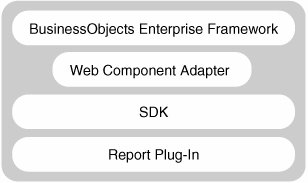The Server Tier: Introduction to the BusinessObjects Enterprise Framework
| The BusinessObjects Enterprise Framework, the backbone of BusinessObjects Enterprise, provides a distributed mechanism that manages the interaction and communication of the BusinessObjects Enterprise services that make up the server tier, as well as communication between this server tier and the BOE SDK. Each BusinessObjects Enterprise service uses the framework to describe the capabilities it offers and to discover other services that are registered with the framework. The framework treats each of the registered services as equals, which enables one service to use the capability of another BusinessObjects Enterprise server directly, thus enhancing scalability. The Framework's foundation is a communication bus that handles dialogue between the various services and facilitates automatic load-balancing and fault tolerance. This communication bus registers each service, categorizes the type of service, and maintains a tally of the status of each service. For scalability reasons, much of this service interaction is distributed and decentralized. This is one of the reasons BusinessObjects Enterprise leads the industry in scalability. The BusinessObjects Enterprise Framework uses programmatic components, known as plug-ins, to represent each object type within BusinessObjects Enterprise. Plug-ins contain the appropriate properties and methods needed to handle a particular object within BusinessObjects Enterprise, and determine how BusinessObjects Enterprise should treat it. For instance, a service might require information about a Crystal Report, and will use the properties of the Crystal Report plug-in to retrieve the information. The Crystal Report plug-in properties include things like the report title, the database login information for that report, and the report thumbnail image. In contrast, a user plug-in might have the username, the type of login, and the group membership as its properties. Although plug-ins become much more important as you start to explore application development using the BusinessObjects Enterprise SDK, they are a great way to start to explore the capabilities of BusinessObjects Enterprise. Figure 25.2 shows how a plug-in is used. They help you to categorize the types of objects you find in BusinessObjects Enterprise, and understand what you can do with each of them. Figure 25.2. A plug-in is the way BusinessObjects Enterprise exposes the services of a server on the framework. The object types that are part of the BusinessObjects Enterprise Framework are classified in the following groups:
Administration Plug-insAdministration plug-ins provide a way to manage the BusinessObjects Enterprise servers. Each plug-in exposes the control and configuration properties of a server within the BusinessObjects Enterprise system so that you can configure the behavior of each BusinessObjects Enterprise server. These plug-ins also provide activity metrics for each server. Authentication Plug-insAuthentication plug-ins provide a mechanism for BusinessObjects Enterprise to interact with external security systems and treat these systems as native authentication sources. The authentication plug-ins provided with BusinessObjects Enterprise are
Content plug-ins describe the types of objects that end users (report viewers) would typically interact with, such as, but not limited to, a Crystal Report. The content types that are provided as part of BusinessObjects Enterprise are Folder User folder Shortcuts Crystal Reports OLAP Intelligence Microsoft Word Microsoft Excel Microsoft PowerPoint Rich Text Format Adobe Acrobat Text Users User groups Servers Server groups Events Connections Licenses Calendars Object packages Program objects Web Intelligence documents Universes Universe Connections A distribution plug-in allows anyone who is scheduling an object such as a Crystal Report to be able to send that report outside the BusinessObjects Enterprise environment. This facility enables the application to schedule reports to destinations such as e-mail. Distribution plug-ins that are provided with BusinessObjects Enterprise are Disk location FTP server E-mail (SMTP) Note BusinessObjects Enterprise also provides the capability for a Crystal Report to be scheduled to a printer. The printer object is not exposed as a distribution object, but rather as a function of the Crystal Report content plug-in. These plug-ins play a fundamental role in the BusinessObjects Enterprise Framework by encapsulating and exposing the knowledge of the object type that they represent. The remainder of this chapter discusses how these plug-ins are used by the BusinessObjects Enterprise servers within the BusinessObjects Enterprise Framework. |
EAN: 2147483647
Pages: 365

 These authentication types are discussed in more detail in "The Server Tier: Overview of the BusinessObjects Enterprise Services,"
These authentication types are discussed in more detail in "The Server Tier: Overview of the BusinessObjects Enterprise Services,"